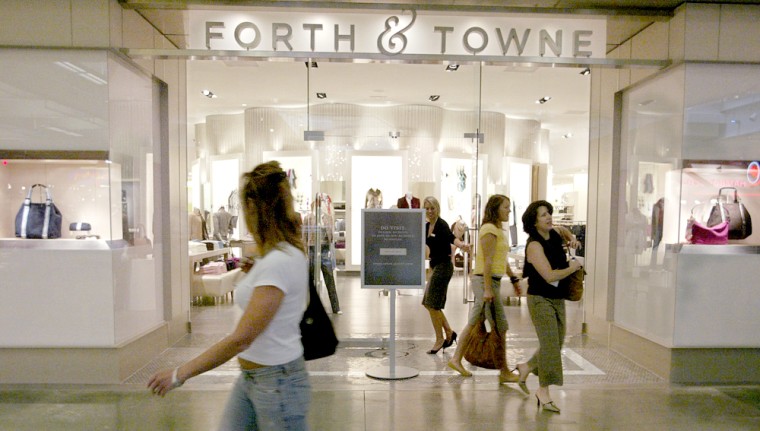Female baby boomers who grew up in Gap jeans but found themselves sized out of the market in middle age have a new shopping alternative: Forth & Towne, Gap Inc.’s first new store concept in more than a decade.
Gap hopes to woo boomers back with a store that combines the service of a boutique, the broad offerings of a department store — and a more forgiving fit.
Forth & Towne, which aims to be quite different from Gap’s three other brands — Gap, Old Navy and Banana Republic — was opening its first store Wednesday in West Nyack, N.Y., north of New York City. Four more will open in the Chicago area next week.
The company is somewhat behind in reaching out to boomers — its competition is well-established and includes upscale discounter Target Corp. and mall-based specialty chains including Chico FAS Inc. that have their own particular look. So Forth & Towne aims to distinguish itself from its rivals with a variety of fashion statements on a selling floor that’s bigger than the average clothing store.
The new West Nyack store has clusters of merchandise: traditional career clothes like structured suits, more loose-fitting but still dressy designs such as knit tweed pants and matte jersey skirts, casual clothing like corduroy pants and body-hugging fashions such as skinny sweater coats and cropped jackets with fur trims.
The merchandise is interpreted differently by each of the store’s private labels: Allegory, Vocabulary, Gap Edition and Prize. A sweater coat from Allegory, which focuses on traditional career wear, is more structured, while shoppers will find more looser-fitting knit wraps at Vocabulary, which offered untailored garments. Gap Edition, which highlights basic items like khakis from the Gap brand, had a pastel blue zip-front cropped knit jacket version, while at Prize, the label that focuses on close-fitting styles, the sweater coats were cinched.
The fashions and accessories, including shoes and handbags, are in a price range between those of Gap and Banana Republic stores. Blazers, for example, are priced from $88 to $148.
Not a mall experience
“The overall experience is very different from what you find anywhere in the mall,” said Gary Muto, formerly president of the Gap brand, who became president of Forth & Towne last fall.
Service, which tends to be lacking at many store chains, is considered a crucial part of the Forth & Towne concept. Sales associates must have experience serving customers, and come from a variety of industries including the spa and hotel businesses.
With the over-35 age group accounting for 39 percent of women’s total apparel expenditures, the market represents a big opportunity for Gap Inc. Muto noted that Gap enjoys about 8 percent of the market share for female shoppers under 35, but less than 3 percent of over-35 customers.
Still, the launch of Forth & Towne — Gap’s first new store concept since Old Navy 12 years ago — comes at a challenging time for the company, whose recovery stalled last year as it struggled to find the right merchandising assortments across its brands. So far this fiscal 2005 year, Gap’s sales at stores open at least a year, known as same-store sales, have averaged a 4 percent decline. That compares with a meager 0.8 percent gain in the prior year.
Profit forecast lowered
The bad news continued last week when the San Francisco-based company, which operates more than 3,000 stores, announced it was lowering its profit forecast for the year due to a weak sales performance this month.
Gap’s stock reflects its struggle.
Earlier this year, the company modified its merchandise strategy, but Paul Pressler, president and CEO, told investors last week it won’t be until next spring that consumers will see the full effect of the changes.
Todd S. Slater, a retail analyst at Lazard Capital Markets LLC, who has toured the Forth & Towne store, applauds Gap’s new approach of appealing to a wide boomer audience with different styles of merchandise, but hopes this won’t present a distraction as the company fixes its other brands. While he praised the store layout, Slater said the merchandise needs “a lot of tweaking.”
“Gap’s challenge is to appeal to a wide audience yet remain a focused specialty business,” he said. “It’s a tremendous opportunity but is complex to execute.”
Still, with Forth & Towne expected to have only a total of 30 stores by 2007, there shouldn’t be any impact on the parent company’s business until at least 2008, and so there will be plenty of time to improve the product, Slater said.
In formulating the Forth & Towne concept, Gap employees spent time shopping with boomer customers. They found that many women shopped at department stores because of the abundance of offerings although they found the big stores overwhelming, said Austyn Zung, senior vice president of design. They want wear fashionable clothing, but don’t want a new wardrobe every year; they want garments that last several seasons.
Fit was also a key concern — Forth & Towne’s garments, which range in size from 2 to 20, are based on a size 10 fit model, instead of a size 8 typically used at most other merchants. Proportions are also longer, reflecting boomers’ more mature bodies.
The fitting rooms, located at the center of the store, were clearly a highlight. The 12 spacious fitting rooms have adjustable lighting, and three-way mirrors. And a cash register is right there for customers ready to check out.
“We wanted to make it more accessible, and to create a sense of community,” Zung said.
